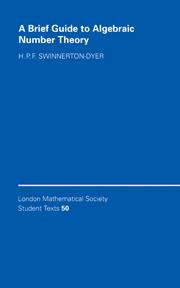Preface
Published online by Cambridge University Press: 05 June 2012
Summary
This book is intended both for number theorists and more generally for working algebraists, though some sections (notably §15) are likely to be of interest only to the former. It is largely an account of mainstream theory; but for example Chapter 3 and §20 should be seen as illustrative applications.
An algebraic number field is by definition a finite extension of Q, and algebraic number theory was initially defined as the study of the properties of algebraic number fields. Like any empire, its borders have subsequently grown. The higher reaches of algebraic number theory are now one of the crown jewels of mathematics. But algebraic number theory is not merely interesting in itself. It has become an important tool over a wide range of pure mathematics; and many of the ideas involved generalize, for example to algebraic geometry. Some applications to Diophantine equations can be found among the exercises, but there has not been room for other applications.
Algebraic number theory was originally developed to attack Fermat's Last Theorem — the assertion that xn + yn = zn has no non-trivial integer solutions for n > 2. It provided proofs that many values of n are impossible; some of the simpler arguments are in §13. But it did not provide a proof for all n, though recently the theorem has been proved by Andrew Wiles, assisted by Richard Taylor, by much more sophisticated methods (which still use a great deal of algebraic number theory).
- Type
- Chapter
- Information
- A Brief Guide to Algebraic Number Theory , pp. vii - xPublisher: Cambridge University PressPrint publication year: 2001

